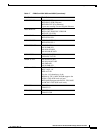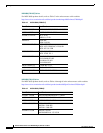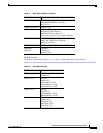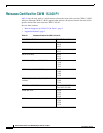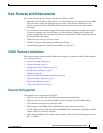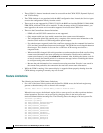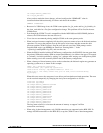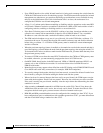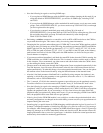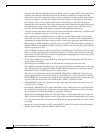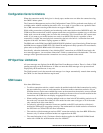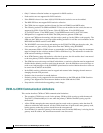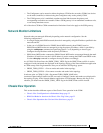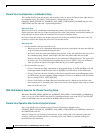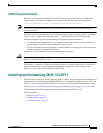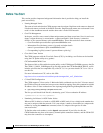
27
Release Notes for the Cisco WAN Manager, Release 15.3.00 P1
OL-11190-01, Rev. C0
CWM Feature Limitations
• Note the following in regard to receiving SNMP traps:
–
If you register an SNMP Manager with the SNMP Agent without changing the bit-mask (if you
accept the default of FFFFFFFFFFFFFFFF), you receive all SNMP traps, including 25302
and 25303.
–
If you register the SNMP Manager with a nondefault bit mask because you do not want certain
groups, such as FFFFFFFFF10701555, you do not receive trap 25302 and 25303, even though
you have registered for that group.
–
If you deselect a currently undefined group such as Group 28 (a bit mask of
FFFFFFFFEFFFFFFF), you can then add traps 25302 and 25303 by editing the trap_filter.conf
file and adding these lines to Group 20 # network connectivity status change traps:
TRAP 25302 and TRAP 25303.
• Performing a switchcc command on a controller card in an IGX or BPX node forces the CWM to
resync with the node again. This causes a delay in receiving status information.
• Changing the line,payload, and medium typesof VXSM-4OC3 causes theCWM to perform awhole
card resync when you change any of the following: the medium type between SONET and SDH for
SONET physical line, the payload type between T1 (VT 1.5 VC 11) and E1(VT 2 VC 12) for the
STS or STM (Au) path or between T1 (VT 1.5 VC 11) and DS3 for the STS path, or the tributary
path between Au4 and Au3 for the STM path in the SDH medium. (A whole card resync takes
several minutes to complete.)
• If you remove and then immediately add back the same IGX feeder when the CWM is running, the
CWM establishes two LINK 0’s with the node. This is treated as a delete, and the node is deleted.
In this situation, Cisco recommends you either remove and add the feeder when the CWM is down,
or, after adding the feeder, restart the CWM.
• Changes made to the node name through the Configuration Center are updated automatically in the
Tree and Inspector views. However, the node name in the title bar of the internal frame does not
update automatically. To make this change, close and reopen the internal frame. You can also update
the attribute values in the internal frame by using the Refresh button of that internal frame.
• After the Line Send parameter LineSendCode is modified by using snmpset, the database is not
updating it, which shows the parameter as not applicable (shows the value as –1). For additional
information, refer to CSCin50480 online.
• The “l_network_id” field in the connection segment or port tables may not be populated correctly.
To ensure collection of an accurate network ID, use the “netw_id” field from the “node” table.
• Note the following in regard to the managing a PXM45-based MGX node and populating the
“peripheral” table: If you are running a release earlier than 4.0.10, CWM 15.0.00 does not populate
(update) the peripheral table. If you are running a 4.0.10 or later release, the status field in the
peripheral table gets updated only during node resync. (If you are managing a PXM1-based MGX
node, the peripheral table status field does not get updated.)
• If the log level for the CWM EM module is set too high or set above the production default value
and many configurations are changed on the switch during a warm start, the sync-up performance is
impacted during the warm start.
• SmartLogging is a special feature for CWM debugging available when the log level is set to Level 2.
It dumps a configurable number of detailed log messages to log files for each Level 2 log message.
For example, when SmartLogging is enabled, an SNMP failure that triggers a Level 2 log message
dumps log messages at all levels immediately before and after this event. Because the feature can
impact performance due to excessive log messages. it should be disabled in normal operation and
enabled only when needed for monitoring performance.



